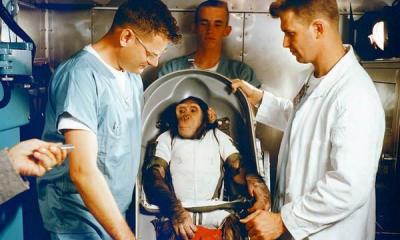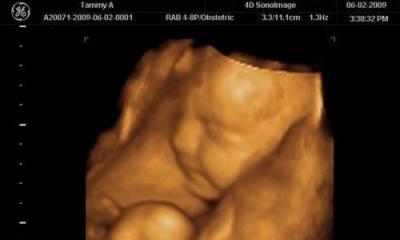There is less and less time left before the birth, there are only six weeks left before meeting the baby, and now you can already clearly distinguish where his head, legs and back are. The child has grown significantly, and your belly has almost reached its maximum size, and the baby in it has occupied almost all the free space, and for childbirth he has taken the most convenient position - head down. Although there may be options for breech presentation, then the method of delivery will need to be discussed with the doctor. Now the baby is actively and daily gaining weight, becoming more and more like a newborn, and if the birth takes place this week, he will be quite viable, and he will need only minor help and medical supervision. Now he is actively accumulating calcium and iron for extrauterine existence, and therefore he needs to eat right and get plenty of rest.
Changes in the body at 34 weeks
34 weeks of pregnancy is the ninth obstetric month, and according to the calendar it is eight months of pregnancy. The third trimester is coming to an end and there are about five to six weeks left until delivery. Rarely, when labor begins exactly at the due date, usually labor is considered urgent from the 38th to the 40th week. Now the tummy has become large, the woman's body has changed a lot and numerous new, sometimes not very pleasant, sensations may arise.
Now your baby has already taken a stable position for childbirth - up to 98% of children for childbirth are in the head position in the uterus, the most optimal for birth. But in this period, although there is little chance, there may be a coup from the wrong positions (pelvic, for example) to the head, and even less often it can be vice versa. You need to try not to provoke moments of great stress or fright, so that the child does not try to roll over. Childbirth is coming soon and your body will begin to actively prepare for them, the structure of the genital tract is changing, so many doctors may recommend limiting or refusing intimacy during this period so as not to provoke the development of infection or candidiasis. This is unfavorable for further childbirth.
Now the chest has become large and heavy, veins have appeared on it, and colostrum can increasingly be separated from the nipples. It is not dangerous and only requires hygiene. There is an increase in training contractions, but they are not dangerous and simply train the walls of the uterus for an early birth. They are irregular, not painful, and disappear quickly after rest or sleep.
Fetal development at 34 weeks: weight, size and sex
By the time of 34 weeks of pregnancy, the child weighs about 2000-2500g and reaches a length of 45-46 cm. His pulmonary system is quite developed, and he will be able to breathe on his own if, for some reason, the birth occurs earlier than the due date. But the child can still retain heat very weakly, and in case of premature birth at this time, he will be placed in a special ward and an incubator with a given temperature. Therefore, it is worth taking care of yourself and reaching the deadline.
Now the child has already reached almost complete perfection - his face has acquired individuality and features similar to those of the parents, the ears have separated from the head and become dense. Gradually, fluff (lanugo) and original grease disappear from the body, which will remain only in large folds, while the skin turns pale - due to the deposition of subcutaneous fat, the vessels cease to shine through it. The child's cheeks are rounded, which are necessary for sucking the breast, he trains the muscles of the face by sucking his finger. After childbirth, he will need this skill at the first breastfeeding immediately in the delivery room - it will be necessary to receive the first and most important drops of colostrum. While the fetus is completely dependent in terms of nutrition and respiration from the mother, receiving oxygen and nutrients, vitamins and minerals through the placenta and umbilical cord. The storage of iron is especially active now, which will be necessary for the formation of one's own blood cells in the first months of independent life, when the replenishment of iron with food will be limited. Preterm babies have poor iron stores and often become anemic in the first months of life.
Now you notice that the child is pushing hard, since there is very little space for him in the uterus - with his movements he will show his mood and character, well-being and discontent. His movements can be different - points and kicks, sipping, moving the head and limbs. Sometimes there are rhythmic shudders of the abdomen - the child often hiccups, training the respiratory and digestive systems. You need to talk to the child, sing to him, read fairy tales, stroke his stomach. If the movements have become unusually scarce or too sharp and painful, you should consult a doctor, this may be a sign of fetal suffering. Normally, in twelve hours, the child should move at least ten times, and ideally, two to three times per hour. During the day, the movements are felt weaker, as the mother is distracted by her usual activities, and in moments of rest, the movements can be clearer.
Now the nervous system and brain tissue are actively maturing, nerve connections are being established between all organs and systems, digestion is actively working, the baby swallows and digests amniotic fluid and forms meconium, his kidneys excrete urine into the amniotic fluid, which is updated every two to three hours. Hormones are actively secreted by almost all endocrine glands of the fetus, all sense organs are well developed.
Feelings of the expectant mother
Now the body has changed a lot, you have gained enough weight, and the stomach has become very large. Therefore, many of the sensations of your body may not be entirely pleasant and comfortable for you. These are temporary difficulties, you have to endure quite a bit, and you will meet with the child. Naturally, the most vivid of the sensations will be the movement of the fetus, and its movements in the area of \u200b\u200bthe ribs and liver can be very sensitive. Sometimes it helps to change the position of the body, walk and rest, so that the baby calms down a little. Rest on your left side - both you and the baby will be most comfortable.
Now you could already get used to pain in the back and lower back, almost two-thirds of women suffer from such sensations in this period. The abdomen at 34 weeks reached almost its maximum size, and the body weight increased greatly, which causes a shift in the center of gravity of the body. In addition, there are also hormonal changes in the body, relaxation of the ligaments and joints, which affects the gait and gives pain. To reduce them, you need to wear a special bandage, monitor your posture, wear comfortable shoes and clothes. Increasing weight can cause pain in the legs and knees, changes in the veins. In order to reduce such discomfort, you need to unload your legs more often, lifting them up, sit with a small footrest, and before going to bed it is useful to massage the legs, cool foot baths.
Relaxation of the ligaments in the sacrum, pelvic region and joints leads to discomfort in these areas, the formation of a duck gait, and sometimes the formation of a dangerous complication - symphysitis, a pathology in the area of the pubic joint. Now you need to strictly monitor your feelings, they should not lead to an increase in the tone of the uterus, the release of blood from the vagina and contractions. The appearance of such symptoms is a reason for the immediate call for an ambulance and hospitalization in the hospital.

Childbirth at 34 weeks
Although the gestation period is already solid, and you should have all the bags and documents for the maternity hospital collected, the birth at this time will be considered premature, and the baby born prematurely. It is important that you always have a phone with you, so that you can call your loved ones in case of emergency, who can accompany you if contractions suddenly begin. Childbirth can take you anywhere, so always carry your exchange card and your documents with you.
Before considering the baby full-term for another three weeks, and if possible, you should take care of yourself, but if you feel cramping pains in the abdomen, water has moved or leaks, there is bloody discharge, pulls the lower abdomen and lower back - most likely, childbirth has begun. Mom and baby are not yet quite ready for such childbirth, and often they can be complicated, therefore, it is important to be in the hospital during childbirth, under the supervision of doctors.
The chances of survival for a child are almost 100%, he can breathe on his own, all his organs and systems work quite actively, but he does not keep the temperature well and needs warming and special care. On average, the baby will spend several weeks in the children's department until he gets stronger and is able to suckle, gain weight and warm his body on his own. Often these children are not even called premature, but born prematurely.
The state of the uterus at 34 obstetric weeks
By the 34th week, the uterus has grown many times and occupies almost the entire abdominal cavity. It weighs about a kilogram, and its walls are about 2 cm thick. The height of the uterine fundus is now about 34 cm, this is almost the maximum height, the amount of amniotic fluid now also reaches a maximum of one liter. The waters are renewed regularly, once every two or three hours, they are sterile, have a special composition depending on the food taken.
The abdomen is greatly enlarged, the navel is turned out and cannot be hidden under clothing. In shape, it can be pointed or round, due to the size of the abdomen, movements become smooth and slow, especially when changing body position.
During this period, the walls of the uterus should be relaxed with rare training contractions, the increased tone of the uterus adversely affects the child and brings discomfort to the mother. With a constant tone, you should immediately contact the hospital, this can be a threat to the fetus. The doctor will also carefully monitor the cervical region - a short cervix is the result of isthmic-cervical insufficiency and can lead to premature birth. In such cases, complete sexual and physical rest is prescribed in order to bring the fetus to the due date as long as possible.
Ultrasound examination (Uzi)
During this period, planned ultrasound is usually not prescribed, but for special indications, an additional study may be indicated. If you have not previously undergone an ultrasound scan, it will be necessary to evaluate all the main ultrasound indicators - to clarify the gestational age, the estimated weight and height of the fetus, to see the sex of the child, and also to assess the degree of its development - are there any defects and abnormalities during pregnancy, is there any intrauterine pod growth retardation.
The ultrasound is deciphered by a doctor - according to the study, the presentation and position of the fetus, the condition of the walls and cervix, the umbilical cord, the amount of amniotic fluid and location, the thickness of the placenta and its degree of maturity look. If necessary, an additional study will be prescribed - doplerometry of the fetal blood flow, which will show how actively the fetus receives nutrition and oxygen. During this period, 3D ultrasound is possible, but due to the large size of the fetus, it is impossible to see it entirely on the monitor screen, you can only view individual parts.

cord entanglement
Sometimes, an ultrasound scan reveals a condition of entanglement of the umbilical cord on the body or neck of the fetus. This condition often scares pregnant women, but do not worry. Loops of the umbilical cord can be on the body or neck of the fetus during fetal movements, with polyhydramnios, with a long umbilical cord or fetal hypoxia. Often, these loops disappear by childbirth. If, however, the entanglement of the umbilical cord, according to ultrasound data, remains before childbirth, during the birth of the baby’s head, the midwife provides the mother and the heart with a special benefit, carefully removing the noose from the neck. If necessary, the baby is also further treated with additional treatment if the entanglement interfered with the normal delivery of oxygen.
Allocations
In the period of 34 weeks, the discharge should be quite physiological, these are mucous discharges of a small volume, transparent or with a slight milky tint, odorless and pathological impurities. With increased secretions, with the appearance of a mucous lump on the linen, mucus with streaks of blood, it is worth thinking about the discharge of the mucous plug. It usually goes away a few days or weeks before delivery, and until then protects the cervix and cervical canal from infection. Minor mucous discharge may be a variant of the norm due to the presence of a mucous plug, but if the discharge is plentiful, liquid with a sweetish odor and constantly leaks, it is worth testing for amniotic fluid leakage - if there are defects in the fetal bladder and water is leaking, you can’t hesitate, you need to go immediately to the hospital and decide on the prolongation of pregnancy. Defects in the fetal bladder are capable of passing dangerous infections to the fetus, which will be a risk to his life and the life of the mother.
No less dangerous is the change in the nature of the discharge, since in the last weeks of pregnancy, due to the restructuring of the body, it is easy to pick up various infections, including sexually transmitted ones. Especially dangerous is the presence of earthy, gray, greenish or yellow discharge, with impurities of mucus, pus, flakes, crumbly, frothy or with an unpleasant pungent odor. Infections also cause discomfort, itching and burning in the vagina and perineum. With this, you should immediately consult a doctor, take a smear and treat the infection. No less dangerous is thrush during pregnancy, it is manifested by a tooth and a burning sensation with curdled discharge.
Particularly dangerous can be spotting, spotting or bleeding from the genital tract, in this condition, immediate hospitalization is necessary, and the determination of the causes of bleeding with a decision on the further course of pregnancy. With placental abruption or the onset of labor, the woman is immediately transferred to the delivery room or operating room.
Stomach ache
During this period, the stomach should not hurt during a normal pregnancy. There may be a pulling sensation due to tension in the skin and ligaments holding the uterus. If you experience any bleating in the abdomen, you should immediately consult a doctor - these may be signs of digestive problems, acute appendicitis, cholecystitis, constipation, poisoning, urinary tract infections. Under such conditions, there will be nausea, stool disorders and vomiting. But this happens infrequently, mostly abdominal pain occurs with threats to pregnancy and premature birth.
Especially carefully you need to monitor your well-being, if the stomach stiffens, pulls the lower abdomen and the lower back hurts, perhaps this is the start of contractions and childbirth. No less dangerous is the appearance against the background of such symptoms of bloody contents from the vagina, nausea, increased pressure, severe swelling.
No less dangerous are pains in the abdomen of a sharp nature without contractions with or without bleeding, with a sharp pallor and a violation of the general condition. These may be signs of placental abruption, a complication that is dangerous for the mother and fetus, when the nutrition of the fetus is disturbed and severe bleeding occurs. In this state, the count goes on for minutes, immediate delivery is necessary.
Colds and treatments
The immunity of a pregnant woman in late pregnancy is physiologically reduced, and therefore, especially in the off-season, colds and flu become dangerous for her. Almost half of pregnant women in this period can be ill with ARVI, when there is fever, general malaise, cough, runny nose and loss of appetite. Although the child has its own immune system and can defend itself against viruses, they can negatively affect the structure and function of the placenta, leading to its accelerated aging and fetal hypoxia.
How to treat a cold, be sure to ask a doctor, self-medication in this period is dangerous - many drugs can provoke negative effects on the fetus or cause premature birth. If possible, non-drug methods of treatment are used - bed rest, heavy drinking, herbal infusions that are safe for pregnant women. It is worth remembering that any thermal procedures in this period are prohibited - banks, mustard plasters, hot foot baths.
Mother's diet and weight
By the 34th week of pregnancy, a woman's weight can increase by 10-12 kg, depending on the physique, the gains range from 8 to 15 kg. Thin women are allowed to add more. It is important to monitor the weekly increase - it should not exceed 300-500 grams, with increased increases, the development of preeclampsia in pregnant women, kidney pathologies and edema as a result of malnutrition and fluid retention are excluded.
It is important now that it is important to eat properly and fully, in small portions, but often, at least five to six times a day. In the diet, you need to increase the amount of protein and fresh vegetables, fruits, fiber, with a decrease in the amount of salt, fatty and carbohydrate foods. With increased weight gain, the doctor may recommend fasting days - kefir, rice, apple.
Sex
In the absence of contraindications, sex is not prohibited this week, but it is still recommended to slow down and exercise reasonable caution. The female genital tract undergoes particular changes, which may increase their susceptibility to foreign flora and the development of inflammation. Sex will be prohibited with abnormal fetal presentation, with placenta previa or cervical insufficiency, with the threat of premature birth. When making love, you should choose positions with shallow penetration and without pressure on the stomach.
Find out how to determine it.








